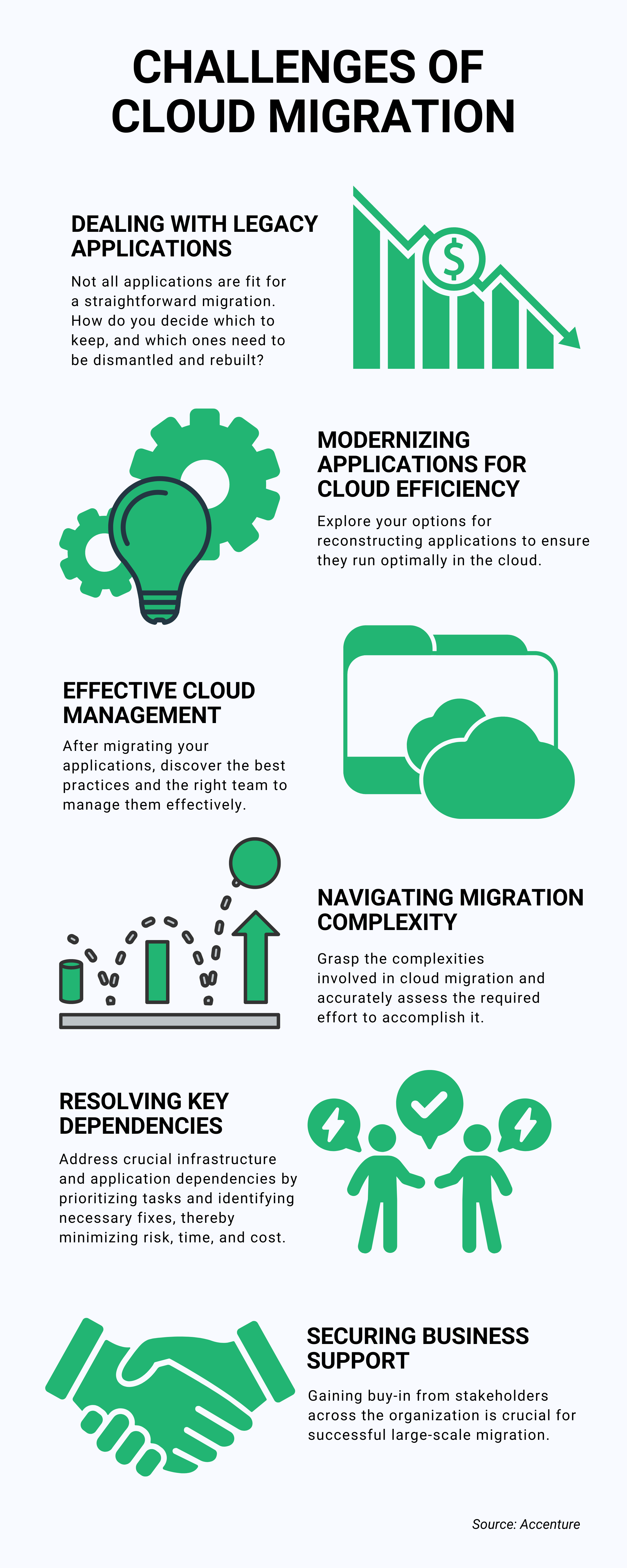
Are you worried about keeping up in the digital age? Today, failing to master cloud migration strategies could threaten your organization’s survival. As enterprises increasingly move to the cloud to spur growth, it's projected that by 2024, over 45% of IT spending will transition from traditional tech solutions to cloud-based ones.
Yet, migrating to the cloud isn't simple. Many projects and initiatives falter, and organizations fail to fully capitalize on their cloud investments when the migration is haphazard or poorly executed. So, how can you ensure a smooth transition and get the best results? Executing a cloud migration demands meticulous planning, stellar project management, and thorough consideration of diverse use cases to guarantee a smooth transition and achieve the best results.
Achieving genuine cloud transformation depends on selecting the appropriate migration strategy for your IT assets and executing a well-thought-out plan. This article will guide you through various cloud migration strategies, equipping you with the knowledge to map your migration journey and ensure a seamless transition to the cloud. The article also explores how businesses can benefit from modern technology solutions like artificial intelligence and its growing capabilities when leaping.
Understanding a Cloud Migration Strategy
A cloud migration strategy is a detailed plan that organizations develop to transfer their infrastructure resources—including data, services, projects, and applications—to the cloud.
Since the early 2000s, when pioneers like Salesforce and Amazon introduced the cloud concept, adoption rates have surged. Furthermore, the COVID-19 pandemic in 2020 accelerated cloud usage as remote working became essential, and innovation needed to continue. According to the 2021 Flexera State of Cloud report, 90% of enterprises anticipate surpassing their previous cloud usage plans this year.
Cloud migration involves transferring digital resources from on-premises setups or another cloud environment to the cloud. Crafting robust cloud migration strategies is the crucial first step in this journey. Today, most organizations have at least one cloud component integrated into their architecture. However, the Flexera report reveals that businesses waste about 30% of their cloud spending, with 61% planning to optimize their current cloud use. So, how can you avoid being part of this statistic?
Indeed, cloud migration strategies are vital for companies transitioning legacy systems to the cloud for the first time and existing cloud users aiming to maximize their investment.
Why Use Cloud Migration Strategies?
Implementing a cloud migration strategy is crucial for identifying and executing the quickest, most cost-effective, and least disruptive transition from on-premises infrastructure to the cloud. It helps determine which application workloads should be discontinued or replaced, which need to be rewritten, which can stay on-premises, and which should be moved to a cloud platform either as-is or with enhancements using native cloud services. Comprehensive enterprise cloud migration strategies will incorporate these approaches to manage the application portfolio effectively.
Given the unique nature of each organization, enterprise cloud migration strategies must be customized to meet specific needs and achieve desired business and technical outcomes. This necessitates a deep understanding of business goals and the application portfolio to gain insights into the total cost of ownership (TCO) and return on investment (ROI) for the migration process.
What are the Benefits of Migrating to the Cloud?
Migrating to the cloud offers many compelling benefits that can transform your business operations. At its core, the cloud's power lies in its flexible and adaptive infrastructure, providing several advantages:
- Reduced Hosting Expenses: Transitioning your projects and business initiatives to the cloud eliminates the hassle and high costs of maintaining physical servers. Cloud providers manage these servers for you through a subscription model, significantly reducing capital expenditure.
- Enhanced Agility and Scalability: According to Gartner, operational agility is a primary motivator for CIOs to embrace cloud technology. Cloud services automatically adjust capacity based on demand, allowing teams to collaborate on updates and issues from any location. This flexibility can provide a substantial competitive advantage.
- Minimized Environmental Footprint: With the cloud, server capacity adjusts to your needs, ensuring you only use the necessary energy and resources. This can significantly reduce the number of data centers you need, potentially down to none, lowering your environmental impact.
- Improved Disaster Recovery: Effective disaster recovery is critical for businesses of all sizes but can be prohibitively expensive for smaller companies. Cloud solutions now make implementing robust backup and recovery systems feasible with less time and upfront investment.
- Enhanced Security: The cloud offers superior security by centralizing sensitive data and applications. Cloud providers continuously roll out security updates to protect against threats, ensuring your data remains secure and allowing you to focus on your core business activities.
However, moving your projects to the cloud isn't without its hurdles. Let's delve into some common challenges businesses face during this transition.
 Cloud Migration Strategies: The Common Challenges
Cloud Migration Strategies: The Common Challenges
Cloud migrations are often complex and fraught with risk. Beyond the challenges outlined, organizations frequently encounter obstacles when transitioning resources to the cloud.
Lack of Strategy
Many organizations embark on cloud migration without dedicating enough time and effort to developing a comprehensive strategy. Successful cloud adoption and implementation demand thorough end-to-end planning, often leveraging AI-driven predictive project management solutions for better coordination. A clear business case must be established for each workload moving to the cloud.
Without clear KPIs to measure post-migration spending or savings, organizations struggle to determine the economic success of their cloud migration. Cloud environments are dynamic, with costs fluctuating rapidly as new services are adopted and application usage increases. KPI-based predictive project management SaaS solutions can help track and optimize expenses more effectively.
Vendor Lock-In
Vendor lock-in poses a significant challenge for cloud adopters. Cloud providers offer numerous services, many of which are not easily transferable to other platforms. Migrating workloads between clouds is a lengthy and costly process. Organizations often find themselves trapped with a provider that no longer meets their needs.
Data Security and Compliance
Data security and compliance are significant hurdles in cloud migration. Cloud services use a shared responsibility model, meaning the organization must secure its data and workloads while the provider secures the infrastructure. This requires correctly configuring security measures and ensuring all services and applications have the appropriate controls. The migration process introduces security risks, such as transferring large volumes of potentially sensitive data and configuring access controls across different environments.
Overcoming these challenges requires meticulous planning, strategic foresight, and ongoing vigilance, often supported by predictive intelligence-enabled project management solutions, to ensure a successful and secure cloud migration.
Effective Cloud Migration Strategies You Must Know
Transitioning to the cloud can transform your business. Start by examining the entire cloud journey to identify the necessary capabilities and actions for successful execution across the cloud migration strategies.
- Define Goals: Goal setting is crucial in cloud migration to ensure everyone is aligned. Goals should be documented, detailing the current infrastructure baseline and key performance indicators (KPIs) to measure success. This is especially critical for IT projects that rely on clear objectives and measurable outcomes.
- Finalize Assets and Timeline: A thorough inventory of applications, data, services, and hardware is essential. Prioritize moving less-critical components first, followed by critical ones with adequate support. The strategy should outline the decommissioning process of the old system.
- Use Pricing Calculators: Cloud costs can escalate quickly. Utilize AWS, Azure, and Google Cloud pricing calculators to forecast expenses and optimize your setup.
- Implement a Disaster Recovery Plan: Ensure a robust disaster recovery plan (DRP) is in place, updated, and tested. A reliable DRP ensures that unexpected issues do not adversely affect project timelines and the cloud migration process.
- Train Employees: Transitioning to the cloud requires employee training, especially when moving from legacy systems. Continuous training is necessary due to frequent updates from cloud providers.
- Avoid Vendor Lock-In: Select a cloud vendor with a future-proof technology roadmap. Consider a multi-cloud strategy to leverage the best features from various providers and mitigate the risk of vendor lock-in.
- Document Everything: Comprehensive documentation of goals, assets, strategies, cost analysis, testing, and training plans is essential. This serves as a reference for stakeholders and compliance audits.
- Test and Measure Success: The migration process concludes with thorough testing and decommissioning old components. Use the predefined KPIs to measure short- and long-term success.
- Stay Updated: To fully benefit from the cloud, stay abreast of new features and updates from providers. Incorporate an update cycle into your cloud migration strategies.
- Focus on Automation: Use middleware tools to automate processes where possible. Establish continuous integration (CI) and continuous delivery (CD) processes to keep up with the fast-evolving cloud environment. Automation streamlines projects, enhancing their efficiency and reducing manual workload.
These cloud migration strategies help you ensure a smooth transition, cost efficiency, and long-term success while supporting your projects' specific needs.
What’s Next?
A meticulous and well-executed migration strategy is crucial to ensure your organization capitalizes on the immense benefits of cloud technology. Missteps in this journey can lead to significant operational disruptions, increased costs, and security vulnerabilities. However, your organization can achieve a seamless and secure transition with a detailed plan that includes defining clear goals, thorough asset inventory, cost management, and continuous employee training.
Utilizing modern solutions like predictive intelligence-based project management solutions and staying updated with the latest cloud advancements will ensure you migrate successfully, optimize, and innovate continuously. TrueProject, a KPI-based predictive project management SaaS solution that improves project health and performance, is in partnership with Zensar and aims to empower your organizations with enhanced cloud project management capabilities. TrueProject uses advanced warning, predictive intelligence, and artificial intelligence to identify potential project issues before they become critical. Zensar’s expert cloud services and TrueProject's cutting-edge SaaS platform optimize your project performance, eliminate potential risks, and proactively manage your projects with timely interventions.
Embrace these solutions and strategies to secure your organization's growth and resilience in the digital age.
 About the Author:
About the Author:
Nivedita Gopalakrishna is a content marketing specialist within the TrueProject Marketing team with extensive experience in blog writing and website content creation across diverse industries. Nivedita’s proficiency in crafting engaging blog posts and informative website content is a testament to her years of experience. Beyond her prowess in written communication, Nivedita has a knack for creating visually appealing static graphics that have played a pivotal role in expanding TrueProject's marketing efforts. She has helped convey the brand's essence through thoughtful design choices and captivate audiences effectively. Outside the professional sphere, Nivedita is a trained classical singer and a fitness enthusiast, embodying creativity and wellness in and out of the office.
Endnotes:
- “Cloud migration: Understanding what it is and how it can transform your business.” Accenture. (n.d). https://www.accenture.com/in-en/insights/cloud-migration-index
- Mohanakrishnan, Ramya. “Top 10 Cloud Migration Strategy Best Practices for 2021.” Spiceworks. February 18, 2022. https://www.spiceworks.com/tech/cloud/articles/cloud-migration-strategy/
- “What is Cloud Migration? Strategy, Process and Tools.” Net App Blue XP. June 01, 2023. https://bluexp.netapp.com/blog/cloud-migration-strategy-challenges-and-steps
- “What is a Cloud migration strategy?” VMWare. (n.d.). https://www.vmware.com/topics/glossary/content/cloud-migration-strategy.html





